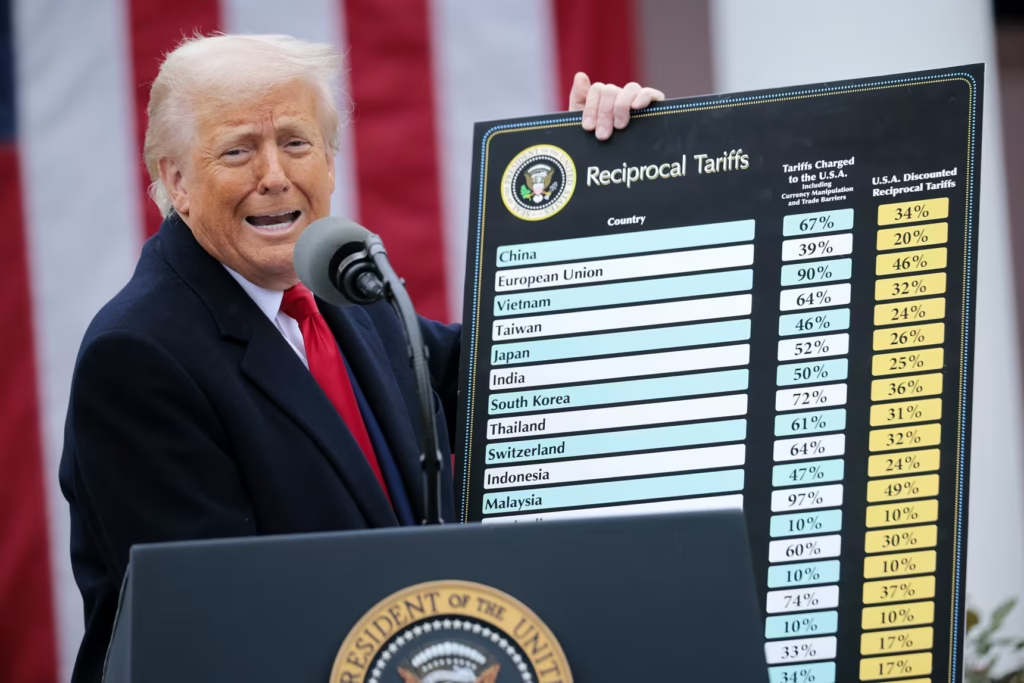More than 50 countries have approached the White House to initiate trade talks following President Donald Trump’s sweeping tariff announcement last week, according to senior administration officials. The announcement, which sent shockwaves through global markets and erased nearly $6 trillion from U.S. stock valuations, is being framed by the Trump administration as a strategic repositioning of America’s role in the international trade system.

Appearing on Sunday political shows, top economic advisers sought to temper fears of a recession, presenting the tariffs as a calculated move intended to strengthen U.S. leverage on the global stage. Despite deep investor anxiety and expectations of a volatile start to Asian market trading on Monday, officials maintained an optimistic tone.
Treasury Secretary Scott Bessent confirmed that since the administration’s announcement on Wednesday, more than 50 nations had initiated tariff-related discussions with the U.S. While specific countries were not named, Bessent described the situation as one that places President Trump in a strong bargaining position.
“He’s created maximum leverage for himself,” Bessent stated on NBC’s *Meet the Press*, adding that dealing with multiple countries simultaneously might present logistical challenges and increase economic uncertainty.
Despite the massive market downturn, Bessent downplayed fears of an impending recession. He cited better-than-expected job growth as evidence that the U.S. economy remains strong, and insisted that the tariff policy was not likely to derail long-term growth.
The tariff rollout has already triggered sharp retaliatory responses from countries like China and raised fears of a global trade war. Trump’s broad tariff package, which includes a 10% levy on all imports from several nations, went into effect on Saturday. Starting Wednesday, country-specific tariffs ranging from 11% to 50% are also set to begin.
JPMorgan economists revised their outlook, predicting a 0.3% decline in full-year U.S. GDP—down from a 1.3% growth forecast—and projected that the national unemployment rate would spike to 5.3%, up from its current 4.2%.
Several countries have already signaled a willingness to negotiate. Taiwanese President Lai Ching-te offered zero tariffs and pledged increased U.S. investments from Taiwanese firms. Israeli Prime Minister Benjamin Netanyahu confirmed plans to seek a waiver from a 17% tariff during an upcoming meeting with Trump.
India, facing a 26% tariff on select goods, has chosen a diplomatic route and entered talks without issuing retaliatory threats. Meanwhile, Italian Prime Minister Giorgia Meloni promised domestic support for local businesses hurt by a pending 20% tariff on European Union goods. Italian wine exporters, speaking at a Verona trade fair, expressed alarm at immediate slowdowns in business.
The financial impact has been historic. The S&P 1500 Composite Index has lost nearly $10 trillion since mid-February, with $6 trillion of that wiped out in just two days following the tariff announcement—marking the worst market week since the COVID-19 crash five years ago.
Despite the staggering losses, White House economic adviser Kevin Hassett denied accusations that the administration intentionally tanked markets to force the Federal Reserve to cut interest rates. A controversial *Truth Social* post by Trump last week, showing him swinging a golf club alongside a caption suggesting market manipulation, only fueled speculation.
Commerce Secretary Howard Lutnick hinted on CBS’s *Face the Nation* that the tariffs could be short-term. “Days or weeks,” he said, suggesting they may be lifted if successful negotiations emerge.
However, scrutiny over the administration’s tariff-setting process has intensified. Reports emerged that duties were even applied to remote, uninhabited territories, including Antarctic islands inhabited only by penguins. Lutnick defended the approach, saying it was necessary to prevent larger nations from using small countries as backdoor routes to avoid tariffs.
“Basically, (Trump) said, ‘I can’t let any part of the world be a place where China or other countries can ship through them,’” Lutnick explained.
As global markets brace for continued volatility and diplomatic efforts accelerate, the Trump administration’s bold trade strategy has reshaped the global economic conversation. While negotiations are now in motion with dozens of nations, the long-term consequences—both politically and economically—remain uncertain.
Whether the tariffs ultimately bring concessions or drag the U.S. into deeper trade conflicts may depend on how these next few weeks of dealmaking unfold.



